[Editor’s Note: Today’s post, originally written in support of a comprehensive Training and Doctrine Command (TRADOC) planning exercise this past Summer, explores the five generations of Soldiers who will serve in the decade ahead. It describes the characteristics of each, and makes the case that understanding their differences will be essential in successfully recruiting, training, and retaining the Soldiers who will defend this nation in our Multi-Domain Operations (MDO) capable force of 2028. Enjoy!]
The Army is a people-centric service. Considering the generations in military and civilian service is useful for analyzing talent management over the next decade. Generational attributes are not a science but rather a starting point for conceptualizing how events and technologies might shape attitudes towards work, organizations, and relationships. They therefore are a foundational element for recruiting, retention, training, and other components 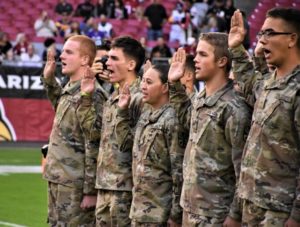 of TRADOC responsibilities. Soldiers entering our Army today will enter mid-level leadership ranks by 2028. The middle years of this decade will see today’s recruits stepping into noncommissioned officer ranks; by 2028 some will be entering sergeant first class status, while today’s just-commissioned lieutenant will be in company command.
of TRADOC responsibilities. Soldiers entering our Army today will enter mid-level leadership ranks by 2028. The middle years of this decade will see today’s recruits stepping into noncommissioned officer ranks; by 2028 some will be entering sergeant first class status, while today’s just-commissioned lieutenant will be in company command.
For the first time in history, there will be five generations serving the U.S. Army as of 2028. This could result in significant differences in world views, values, and technological literacy amongst its military and civilian populations. Army culture will be even more important than it is today in serving as a common and unifying standard across all five of these generations (see the graphic below for the birth years that identify the generations addressed here).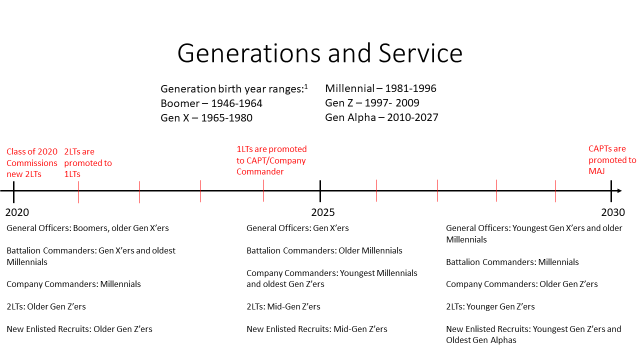
Characteristics associated with each of the five generations are described below:
Baby Boomers (born 1946-1964) – General officers and senior civilian leaders today
Strengths:
-
-
-
- More committed to their roles than other generations
- “Workaholics” who value long hours and have the value of experience/expertise accumulated over a career
-
-
Weaknesses:
-
-
-
- Prefer structure and discipline and are less welcoming of change
- The least tech-savvy of the five generations; struggle to keep pace with rapid developments
-
-
Gen X (b. 1965-1980) – Next Army senior leaders
Strengths:
-
-
-
- 70% of organizations believe they are the best overall workers
- Prefer a work/life balance
- Independent and self-sufficient
-
-
Weaknesses:
-
-
-
- Value doing something quickly over doing it perfectly
- Less than 40% are happy with their organizations’ senior management
- More cynical than previous generations
-
-
Millennials (b. 1981-1996) – Current battalion executive officers (XOs)/ operations officers (S3s); MDO battalion and brigade commanders
Strengths:
-
-
-
- Better at using their own creative processes than taking explicit direction
- Tech-savvy generation (rely on tech for communication)
- Concerned with ethics and social responsibility of their organizations
- Value work/life balance and prefer flexible schedules
-
-
Weaknesses:
-
-
-
- Hold a different perception of work ethic as they tend to work fewer hours per week than their generational predecessors
- Nearly three-quarters (71%) will leave a job in two years if they feel they are not developing their desired leadership skills
-
-
Gen Z (b. 1997-2009) — Current lieutenants; MDO XOs/S3s
Strengths:
-
-
-
- “Always on” and able to multitask
- Most tech-competent generation currently in the workforce
- Have strong community identities, ties, and values (work to improve their community)
- Value mental health at work and work/life balance
-
-
Weaknesses:
-
-
-
- Expect transparent leadership and communication and are unlikely to show strong company loyalty
- Rely on technology to solve problems for them
- Do not remember a time without social media and having easily accessible internet
-
-
Gen Alpha (b. 2010-2027) – MDO soldiers
Anticipated Strengths:
-
-
- Able to work anywhere (less inclined towards traditional office jobs)
- High cognitive ability requiring challenges and individualized learning
- Tech natives/tech-literate with expectation to use tech in the workplace
- Experience with AI-guided education focused on video-content learning
-
Anticipated Weaknesses:
-
-
- Will not distinguish lines of personal/professional discourse
- Prefer the company of computers over people
- Tend to be more sedentary and socially isolating than previous generations, making in-person teamwork more difficult
- Less manpower in this generation due to falling birthrate
-
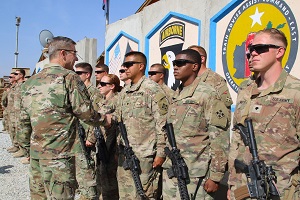 As the last of the Boomers transition from military service, they will remain a major part of the civilian workforce throughout the next decade. Generation X and Millennials will make up the Army’s senior leadership from brigade command to the Chief of Staff of the Army. These leaders might not conform to widely accepted generational attributes because, given their significant time in service, some of these characteristics may be smoothed out or appear less prevalently. A major may not have as much in common with his civilian generational peers because of ingrained military culture and a highly stressful work environment. Some attributes could prove to be more “sticky,” like emphasis on spending time with families or comfort with the role of technology in their day-to-day lives.
As the last of the Boomers transition from military service, they will remain a major part of the civilian workforce throughout the next decade. Generation X and Millennials will make up the Army’s senior leadership from brigade command to the Chief of Staff of the Army. These leaders might not conform to widely accepted generational attributes because, given their significant time in service, some of these characteristics may be smoothed out or appear less prevalently. A major may not have as much in common with his civilian generational peers because of ingrained military culture and a highly stressful work environment. Some attributes could prove to be more “sticky,” like emphasis on spending time with families or comfort with the role of technology in their day-to-day lives.
 Generations Z and Alpha are living through several formative shocks—pandemic, recession, and social unrest—that will have major impacts on how they view the Army, national security, and service. TRADOC will need to develop new messages and communication methods to convince them to join the Army. This updated messaging will need to start immediately to reach members of Gen Z before they anchor their perceptions around these societal shocks. Starting in 2023, the oldest members of Gen Alpha will turn 13 and start to form their own opinions about service; they will be 18 in 2028 and entering the recruiting pool. Both of these populations will respond positively to a technologically enhanced and competent force.
Generations Z and Alpha are living through several formative shocks—pandemic, recession, and social unrest—that will have major impacts on how they view the Army, national security, and service. TRADOC will need to develop new messages and communication methods to convince them to join the Army. This updated messaging will need to start immediately to reach members of Gen Z before they anchor their perceptions around these societal shocks. Starting in 2023, the oldest members of Gen Alpha will turn 13 and start to form their own opinions about service; they will be 18 in 2028 and entering the recruiting pool. Both of these populations will respond positively to a technologically enhanced and competent force. 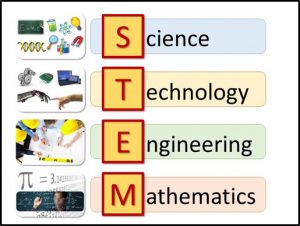 Successfully appealing to and recruiting first-generation Americans, specifically those that value science, technology, engineering, and mathematics (STEM) educations, could determine the success of transitioning to a higher-tech MDO force.
Successfully appealing to and recruiting first-generation Americans, specifically those that value science, technology, engineering, and mathematics (STEM) educations, could determine the success of transitioning to a higher-tech MDO force.
If you enjoyed this post, check out:
The Convergence: The Future of Talent and Soldiers with MAJ Delaney Brown, CPT Jay Long, and 1LT Richard Kuzma and listen to the associated podcast here.
New Skills Required to Compete & Win in the Future Operational Environment
Setting the Army for the Future (Parts II and III)
The Trouble with Talent: Why We’re Struggling to Recruit and Retain Our Workforce, by Sarah L. Sladek
>>> REMINDER: The Mad Scientist Initiative will facilitate our next webinar on 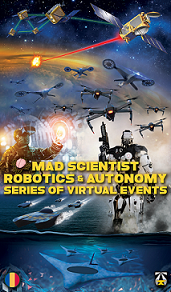 Thursday, 12 November 2020 (1100-1200 EST):
Thursday, 12 November 2020 (1100-1200 EST):
The Future of Unmanned Maritime Systems – featuring proclaimed Mad Scientist Mr. Sam Bendett, Researcher and Consultant, CNA; Mr. Kelvin Wong, Editor: Unmanned Maritime Systems at Janes; and Mr. Montrell Smith, Assistant Program Manager, Advanced Autonomy Capabilities, Unmanned Maritime Systems, U.S. Navy.
In order to participate in this virtual event, you must first register here [via a non-DoD network].
- Disclaimer: The views expressed in this post do not necessarily reflect those of the Department of Defense, Department of the Army, Army Futures Command (AFC), or Training and Doctrine Command (TRADOC).



